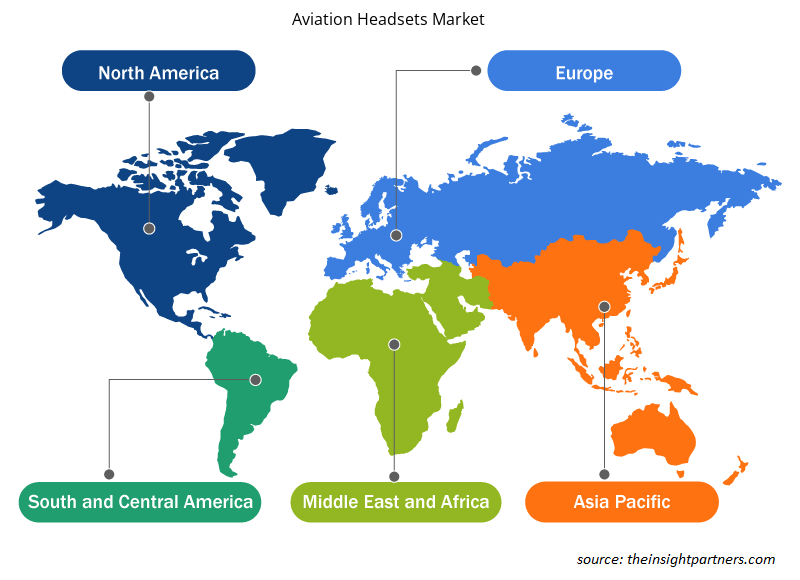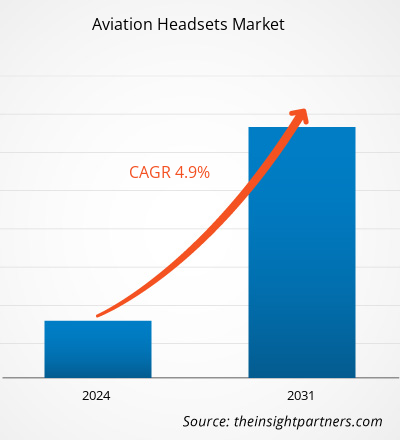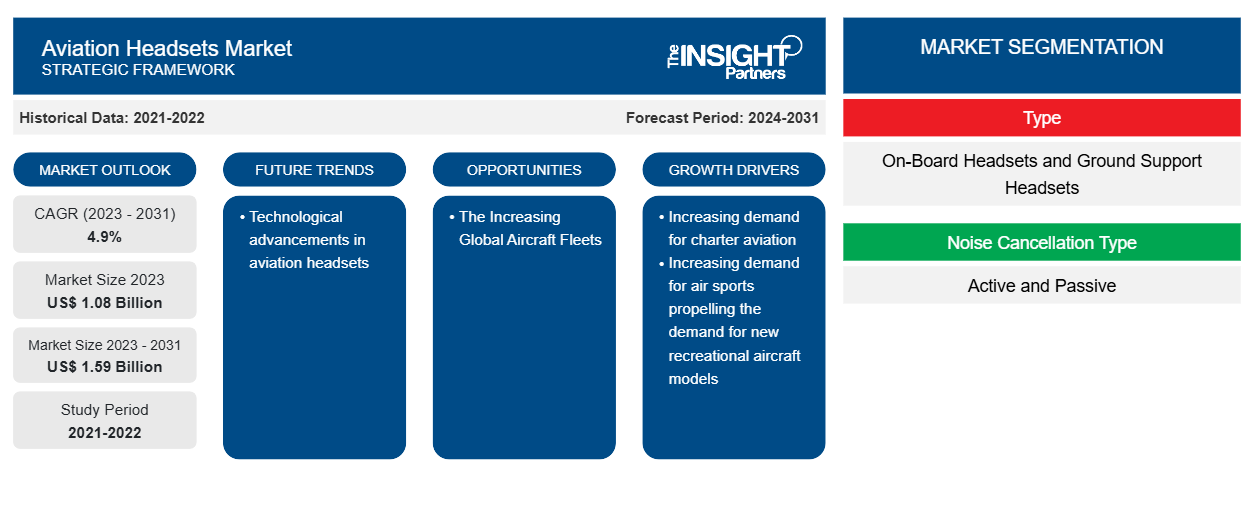Se prevé que el tamaño del mercado de auriculares para aviación alcance los 1.590 millones de dólares estadounidenses en 2031, frente a los 1.080 millones de dólares estadounidenses en 2023. Se espera que el mercado registre una CAGR del 4,9 % durante el período 2023-2031. Es probable que los avances tecnológicos en auriculares para aviación sigan siendo una tendencia clave en el mercado.
Análisis del mercado de auriculares para aviación
El ecosistema del mercado de auriculares para aviación es diverso y está en constante evolución. Sus partes interesadas son los proveedores de componentes, los fabricantes de auriculares, los distribuidores y los usuarios finales. Los principales actores ocupan lugares en los distintos nodos del ecosistema del mercado. Los proveedores de componentes suministran diferentes componentes, como productos semiconductores/chipsets, micrófonos y componentes de altavoces, a los fabricantes de auriculares para aviación, quienes luego los utilizan para fabricar y diseñar los productos finales de auriculares para aviación. El producto final se distribuye luego a los usuarios finales a través de diferentes medios, como las ventas directas a través de distribuidores de la empresa en todo el sector de la aviación.
Descripción general del mercado de auriculares para aviación
Entre los principales fabricantes del mercado de auriculares para aviación se encuentran empresas como Bosch Security & Safety Systems, Bose Corporation, David Clark Company, Lightspeed Aviation, GBH Headsets, Pilot Communications, Plantronics Inc., SEHT Limited y Sennheiser Electronic GmbH & Co. Kg. Estas empresas se dedican al diseño, fabricación y venta de una amplia gama de auriculares para aeronaves a usuarios finales como aerolíneas, empresas de mantenimiento, reparación y revisión (MRO), fabricantes de equipos originales (OEM) de aviación y fuerzas de defensa, respectivamente.
Personalice este informe según sus necesidades
Obtendrá personalización en cualquier informe, sin cargo, incluidas partes de este informe o análisis a nivel de país, paquete de datos de Excel, así como también grandes ofertas y descuentos para empresas emergentes y universidades.
-
Obtenga las principales tendencias clave del mercado de este informe.Esta muestra GRATUITA incluirá análisis de datos, desde tendencias del mercado hasta estimaciones y pronósticos.
Impulsores y oportunidades del mercado de auriculares para aviación
La creciente demanda de deportes aéreos impulsa la demanda de nuevos modelos de aeronaves recreativas
El aumento de la entrega de aviones deportivos ligeros debido a una mayor conciencia de los deportes aéreos entre los jóvenes de todo el mundo está ayudando a la implementación de modelos de aviones recreativos de nueva generación. Por ejemplo, la creciente flota de LSA (aviones deportivos ligeros) existentes está generando la demanda de nuevos pilotos y accesorios para auriculares en todo el mundo. Además, la demanda de LSA está impulsada principalmente por el creciente interés en actividades recreativas como el paracaidismo, lo que allana el camino para que nuevos actores establezcan negocios, mientras que los actores existentes expanden su negocio estableciendo una nueva base y comprando nuevos aviones. Por lo tanto, la creciente flota de aviones deportivos ligeros en todo el mundo está ayudando a la adopción de auriculares de aviación a nivel mundial.
Las crecientes flotas de aeronaves mundiales
Según la investigación secundaria de The Insight Partners, la flota mundial de aviones comerciales en 2022 era de alrededor de 25.578 aviones y es probable que alcance alrededor de 28.398 aviones para fines de 2024 y alrededor de 36.413 aviones para fines de 2034. Además, según las previsiones reveladas por dos de los principales fabricantes de equipos originales de aviones, es decir, Boeing y Airbus, se espera que se entreguen más de 40.800 aviones para fines de 2042, lo que generará aún más demanda de nuevos pilotos y auriculares en los próximos años.
Análisis de segmentación del informe de mercado de auriculares de aviación
Los segmentos clave que contribuyeron a la derivación del análisis del mercado de auriculares de aviación son el tipo de cancelación de ruido y la aplicación.
- Según el tipo, el mercado de auriculares para aviación se segmenta en auriculares de a bordo y auriculares de apoyo en tierra. El segmento de auriculares de a bordo tuvo una mayor participación de mercado en 2023.
- Según el tipo de cancelación de ruido, el mercado de auriculares para aviación se segmenta en activo y pasivo. El segmento activo tuvo una mayor participación de mercado en 2023.
- Según la aplicación, el mercado de auriculares para aviación se segmenta en aeronaves comerciales, aeronaves militares y aviación general. El segmento comercial tuvo una mayor participación de mercado en 2023.
Análisis de la cuota de mercado de los auriculares para aviación por geografía
El alcance geográfico del informe de mercado de auriculares de aviación se divide principalmente en cinco regiones: América del Norte, Europa, Asia Pacífico, Medio Oriente y África, y América del Sur.
América del Norte ha dominado el mercado en 2023, seguida de las regiones de Europa y Asia Pacífico. Además, es probable que Asia Pacífico también sea testigo de la CAGR más alta en los próximos años. Esto se debe principalmente a las entregas esperadas de más de 18.800 nuevos aviones comerciales en toda la región en las próximas dos décadas. Además, el creciente número de aeropuertos en la región de Asia Pacífico también está impulsando el despliegue de un mayor número de aviones en la región, lo que probablemente genere nuevas oportunidades para los proveedores del mercado en los próximos años.
Perspectivas regionales del mercado de auriculares para aviación
Los analistas de Insight Partners explicaron en detalle las tendencias y los factores regionales que influyen en el mercado de auriculares para aviación durante el período de pronóstico. Esta sección también analiza los segmentos y la geografía del mercado de auriculares para aviación en América del Norte, Europa, Asia Pacífico, Oriente Medio y África, y América del Sur y Central.

- Obtenga datos regionales específicos para el mercado de auriculares de aviación
Alcance del informe de mercado de auriculares para aviación
| Atributo del informe | Detalles |
|---|---|
| Tamaño del mercado en 2023 | 1.080 millones de dólares estadounidenses |
| Tamaño del mercado en 2031 | 1.590 millones de dólares estadounidenses |
| CAGR global (2023 - 2031) | 4,9% |
| Datos históricos | 2021-2022 |
| Período de pronóstico | 2024-2031 |
| Segmentos cubiertos |
Por tipo
|
| Regiones y países cubiertos |
América del norte
|
| Líderes del mercado y perfiles de empresas clave |
|
Densidad de actores del mercado: comprensión de su impacto en la dinámica empresarial
El mercado de auriculares para aviación está creciendo rápidamente, impulsado por la creciente demanda de los usuarios finales debido a factores como la evolución de las preferencias de los consumidores, los avances tecnológicos y una mayor conciencia de los beneficios del producto. A medida que aumenta la demanda, las empresas amplían sus ofertas, innovan para satisfacer las necesidades de los consumidores y aprovechan las tendencias emergentes, lo que impulsa aún más el crecimiento del mercado.
La densidad de actores del mercado se refiere a la distribución de las empresas o firmas que operan dentro de un mercado o industria en particular. Indica cuántos competidores (actores del mercado) están presentes en un espacio de mercado determinado en relación con su tamaño o valor total de mercado.
Las principales empresas que operan en el mercado de auriculares para aviación son:
- Sistemas de seguridad y protección de Bosch
- Corporación Bose
- Compañía David Clark
- Aviación de Faro
- Auriculares GBH
Descargo de responsabilidad : Las empresas enumeradas anteriormente no están clasificadas en ningún orden particular.

- Obtenga una descripción general de los principales actores clave del mercado de auriculares para aviación
Noticias y desarrollos recientes del mercado de auriculares para aviación
El mercado de auriculares para aviación se evalúa mediante la recopilación de datos cualitativos y cuantitativos a partir de una investigación primaria y secundaria, que incluye publicaciones corporativas importantes, datos de asociaciones y bases de datos. A continuación, se enumeran algunos de los avances en el mercado de auriculares para aviación:
- Bose, el líder en tecnología de auriculares de aviación de primera calidad, anunció hoy su última innovación: los nuevos auriculares para aviación A30. Presentados en la exposición aeroespacial SUN 'n FUN en Lakeland, Florida, los A30 son un producto completamente nuevo, diseñado para brindarles a los pilotos la mejor combinación de comodidad, cancelación de ruido y claridad de audio de todos los auriculares para aviación del mercado. (Fuente: Bose, comunicado de prensa, marzo de 2023)
Lightspeed Aviation presentó hoy el Lightspeed Delta Zulu, el primero de la próxima generación de auriculares ANR. Este revolucionario auricular ANR para aviación presenta un conjunto de nuevas características y anuncia una nueva categoría de productos de aviación denominada "dispositivos portátiles de seguridad". (Fuente: Lightspeed Aviation, comunicado de prensa, septiembre de 2022)
Informe sobre el mercado de auriculares para aviación: cobertura y resultados
El informe “Tamaño y pronóstico del mercado de auriculares de aviación (2021-2031)” proporciona un análisis detallado del mercado que cubre las siguientes áreas:
- Tamaño del mercado de auriculares de aviación y pronóstico a nivel mundial, regional y nacional para todos los segmentos clave del mercado cubiertos bajo el alcance
- Tendencias del mercado de auriculares para aviación, así como dinámicas del mercado, como impulsores, restricciones y oportunidades clave
- Análisis detallado de las cinco fuerzas de Porter
- Análisis del mercado de auriculares para aviación que cubre las tendencias clave del mercado, el marco global y regional, los principales actores, las regulaciones y los desarrollos recientes del mercado.
- Análisis del panorama de la industria y de la competencia que abarca la concentración del mercado, el análisis de mapas de calor, los actores destacados y los desarrollos recientes del mercado de auriculares para aviación
- Perfiles detallados de empresas
- Análisis histórico (2 años), año base, pronóstico (7 años) con CAGR
- Análisis PEST y FODA
- Tamaño del mercado, valor/volumen: global, regional y nacional
- Industria y panorama competitivo
- Conjunto de datos de Excel
Informes recientes
Testimonios
Razón para comprar
- Toma de decisiones informada
- Comprensión de la dinámica del mercado
- Análisis competitivo
- Información sobre clientes
- Pronósticos del mercado
- Mitigación de riesgos
- Planificación estratégica
- Justificación de la inversión
- Identificación de mercados emergentes
- Mejora de las estrategias de marketing
- Impulso de la eficiencia operativa
- Alineación con las tendencias regulatorias























 Obtenga una muestra gratuita para - Mercado de auriculares para aviación
Obtenga una muestra gratuita para - Mercado de auriculares para aviación